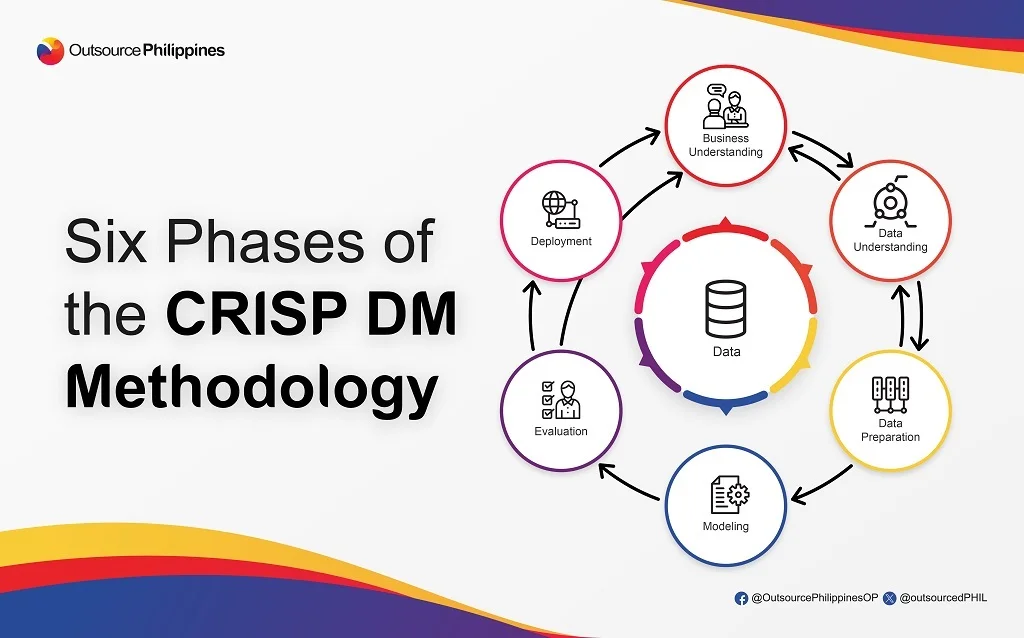Organizations continue to seek effective methodologies to transform raw data into actionable insights toward business success. One major framework that can be applied in this day and age is cross-industry standard process for data mining or CRISP-DM. It’s a widely embraced structured approach for data mining projects. In an era where data-driven decision-making is paramount, CRISP-DM stands as a versatile and comprehensive methodology, offering a roadmap for organizations to navigate the intricate process of extracting valuable knowledge from their datasets.
Whether you’re a seasoned data scientist seeking to harness the power of data or a key business decision maker looking to better implement data mining effectively, understanding CRISP-DM is a crucial step toward unlocking the potential hidden within the vast realms of information. That said, read on to understand the core principles and applications of CRISP-DM, along with its benefits, drawbacks, and real-world significance.

What is Data Mining and Why is It Important?
Data mining is the process of discovering patterns, trends, correlations, and valuable insights from large sets of data. It involves using various techniques and algorithms to analyze and extract useful information from raw data, helping organizations make informed decisions and predictions. The goal of data mining is to uncover hidden patterns and relationships within data that may not be immediately apparent.
Data mining is a key process in today’s data-driven world, enabling organizations to extract valuable insights from vast datasets. Its importance can be further seen and applied in the following ways:
Knowledge Discovery
Through advanced algorithms and analytical techniques, organizations can gain a deeper understanding of their operations, customer behaviors, and market dynamics. This provides a foundation for strategic planning and improved business outcomes.
Predictive Analysis
By analyzing historical data, organizations can build models that forecast future trends and outcomes. This foresight empowers businesses to anticipate market shifts, customer preferences, and potential challenges, allowing for proactive decision-making and a competitive edge in dynamic industries.

Enhanced Decision-Making
Data mining transforms raw data into actionable insights, empowering decision-makers with a comprehensive understanding of various factors influencing their business. Informed decision-making is a must to help businesses adapt to the fast-paced business environment, and data mining ensures that decisions are based on a thorough analysis of relevant information.
Customer Segmentation
Understanding customers is fundamental to business success, and data mining facilitates this through customer segmentation. By analyzing diverse data sources, organizations can categorize customers based on behavior, preferences, and demographics. This then enables targeted marketing efforts, personalized customer experiences, and the development of products and services that align with specific customer segments.
Fraud Detection and Risk Management
Through the analysis of patterns and anomalies in data, organizations can also identify potential fraudulent activities, enhance security measures, and manage risks effectively. This not only protects businesses but also instills trust among customers and stakeholders.
What is CRISP-DM (Cross-Industry Standard Process for Data Mining)?
CRISP-DM serves as a structured and adaptable framework for guiding organizations through the complexities of data mining projects. Developed as an industry standard in the late 1990s, CRISP-DM provides a holistic approach to the data mining life cycle, from understanding business objectives to deploying models into operational environments.

At its core, CRISP-DM is designed to promote collaboration among cross-functional teams, including business stakeholders, domain experts, and data scientists. It encourages a thorough understanding of the business problem at the outset, ensuring that data mining efforts are closely aligned with overarching business goals.
The framework also acknowledges the iterative nature of data mining projects, with feedback loops that allow for adjustments based on ongoing evaluations. Ultimately, CRISP-DM not only provides a systematic and organized approach to data mining but also promotes effective communication and collaboration, essential elements for successful data-driven decision-making within organizations.
The Six Phases of the CRISP DM Methodology
The CRISP-DM methodology’s structured approach ensures a systematic progression from understanding the business problem to deploying practical solutions. It comprises six distinct phases, each playing a crucial role in the success of a data mining initiative:

You may download the infographic above for reference.
What are the Benefits of CRISP-DM?
The CRISP-DM methodology brings various benefits to organizations embarking on data mining projects. Here are some notable ones:
Uniform Framework for Guidelines and Experience Documentation
CRISP-DM provides a uniform framework for guidelines and experience documentation, allowing for the standardization of data mining processes across different industries. This ensures that best practices are followed and facilitates the replication of successful projects.
Cost-Effectiveness and Well-Established Processes
The methodology is cost-effective as it includes a number of processes to carry out simple data mining tasks, and the processes are well established across the industry. This can lead to more efficient and effective data mining projects, ultimately saving time and resources.
Encouragement of Best Practices
Ultimately, CRISP-DM encourages best practices in data mining by providing a structured approach to the entire process. It emphasizes the importance of thorough documentation, which is key to ensuring the reproducibility and reliability of projects.

What are Its Drawbacks?
While the CRISP-DM methodology provides a structured and widely adopted framework for data mining projects, it’s also essential to acknowledge some of its potential drawbacks:
- Iterative Nature: The iterative nature of CRISP-DM, while beneficial for refinement, can be viewed as a drawback in situations where time and resource constraints are significant concerns.
- Limited Guidance on Tools and Techniques: CRISP-DM provides a process-oriented framework but lacks explicit guidance on specific tools and techniques, potentially posing challenges for those less experienced in data mining.
- Lack of Explicit Support for Unstructured Data: Developed in an era dominated by structured data, CRISP-DM doesn’t explicitly address the challenges associated with unstructured data. This may limit its applicability in contemporary data landscapes.
Work with the Top Outsourcing Service Provider for Your Data Mining Needs
The importance of successful data mining projects can’t be overstated in today’s data-driven landscape, and CRISP-DM serves as a reliable approach in navigating the complexities of these endeavors.
For organizations aiming to harness the full potential of CRISP-DM, partnering with a top outsourcing service provider like Outsource-Philippines can be a game-changer. Our expertise in data processing and commitment to excellence can empower organizations like yours to seamlessly implement and derive maximum value from the CRISP-DM methodology. Contact us today to learn more about our topnotch data mining services and take the leap toward transformative insights and strategic success.







